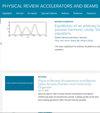Heavy ion linac as a high current proton beam injector
Physical Review Special Topics-accelerators and Beams
Pub Date : 2015-05-18
DOI:10.1103/PHYSREVSTAB.18.050102
引用次数: 36
Abstract
A significant part of the experimental program at Facility for Antiproton and Ion Research (FAIR) is dedicated to pbar physics requiring a high number of cooled pbars per hour. The primary proton beam has to be provided by a 70 MeV proton linac followed by two synchrotrons. The new FAIR proton linac will deliver a pulsed proton beam of up to 35 mA of $36\text{ }\text{ }\ensuremath{\mu}\mathrm{s}$ duration at a repetition rate of 4 Hz (maximum). The GSI heavy ion linac (UNILAC) is able to deliver world record uranium beam intensities for injection into the synchrotrons, but it is not suitable for FAIR relevant proton beam operation. In an advanced machine investigation program it could be shown that the UNILAC is able to provide for sufficient high intensities of ${\mathrm{CH}}_{3}$ beam, cracked (and stripped) in a supersonic nitrogen gas jet into protons and carbon ions. This advanced operational approach will result in up to 3 mA of proton intensity at a maximum beam energy of 20 MeV, $100\text{ }\text{ }\ensuremath{\mu}\mathrm{s}$ pulse duration and a repetition rate of up to 2.7 Hz delivered to the synchrotron SIS18. Recent linac beam measurements will be presented, showing that the UNILAC is able to serve as a proton FAIR injector for the first time, while the performance is limited to 25% of the FAIR requirements.重离子直线加速器作为大电流质子束注入器
反质子和离子研究设施(FAIR)的一个重要实验项目是致力于每小时需要大量冷却pbar的pbar物理。主质子束必须由一个70兆电子伏的质子直线加速器和两个同步加速器提供。新的FAIR质子直线加速器将以4hz(最大)的重复率提供高达35 mA的脉冲质子束,持续时间为$36\text{}\text{}\math {\mu}\math {s}$。GSI重离子直线加速器(UNILAC)能够提供世界纪录的铀束强度注入同步加速器,但它不适合FAIR相关的质子束操作。在一个先进的机器研究程序中,可以证明UNILAC能够提供足够高强度的光束,在超音速氮气射流中裂解(和剥离)成质子和碳离子。这种先进的操作方法将产生高达3 mA的质子强度,最大光束能量为20 MeV,脉冲持续时间为100美元,同步加速器SIS18的重复频率高达2.7 Hz。最近的直线光束测量结果将首次表明,UNILAC能够作为质子FAIR注入器,而其性能仅限于FAIR要求的25%。
本文章由计算机程序翻译,如有差异,请以英文原文为准。
求助全文
约1分钟内获得全文
求助全文
来源期刊
自引率
0.00%
发文量
0
审稿时长
3-8 weeks
期刊介绍:
Physical Review Special Topics - Accelerators and Beams (PRST-AB), is a peer reviewed, purely electronic journal, distributed without charge to readers and funded by contributions from national laboratories. It covers the full range of accelerator science and technology: subsystem and component technologies, beam dynamics; accelerator applications; and design, operation, and improvement of accelerators used in science and industry. This includes accelerators for high-energy and nuclear physics, synchrotron radiation production, spallation neutron sources, medical therapy, and intense beam applications.

 求助内容:
求助内容: 应助结果提醒方式:
应助结果提醒方式:


